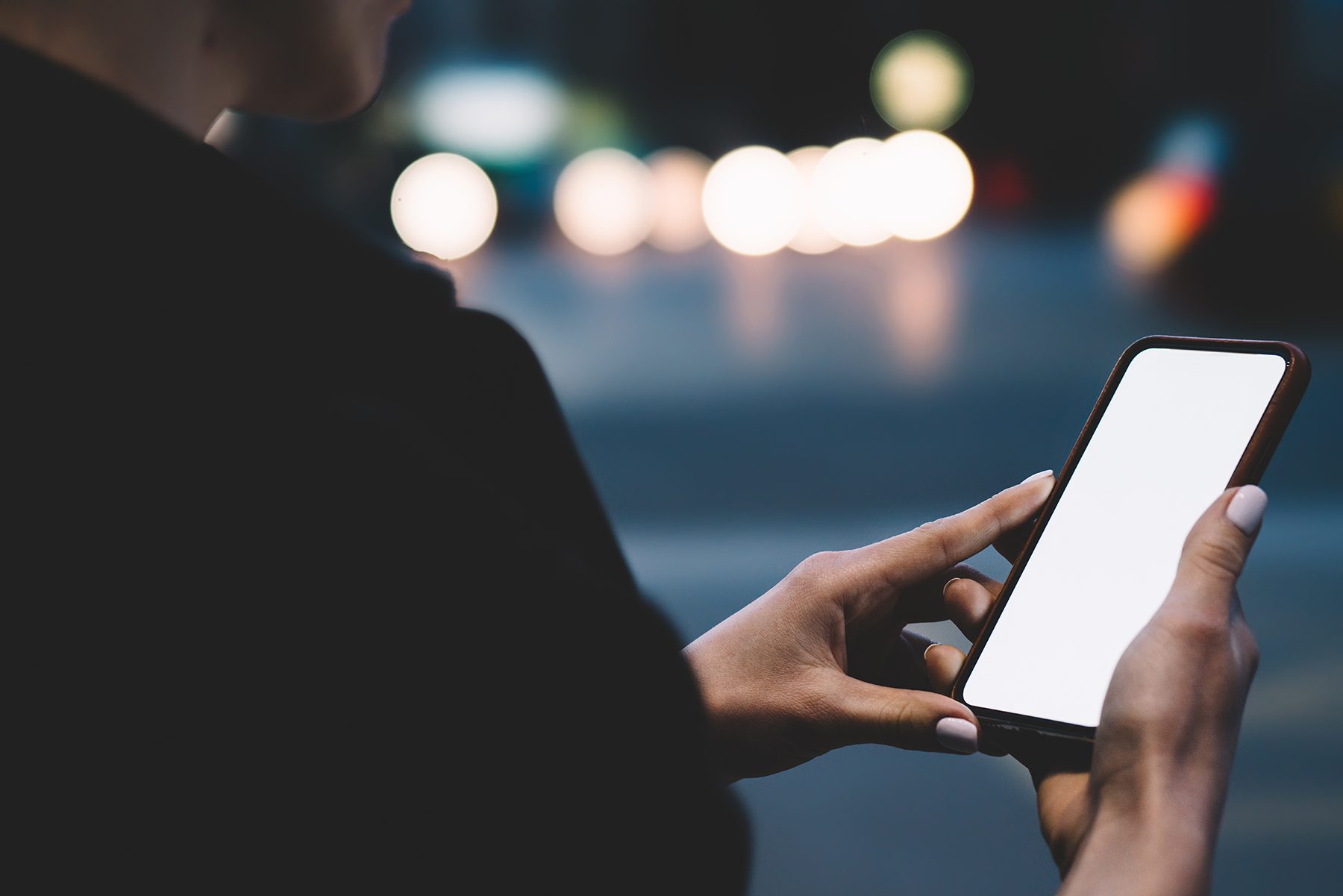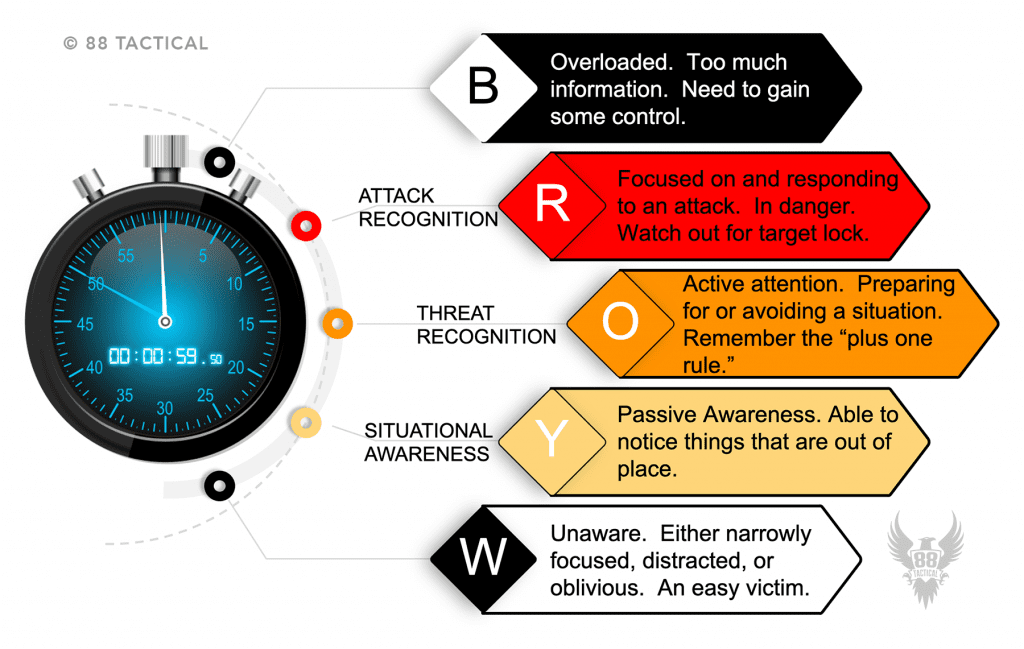It is widely known that most criminals are opportunistic; they look for easy targets and they do not want to work any harder than absolutely necessary. Knowing the color codes of awareness can help you mitigate the risk of having an encounter with one of these criminals. Before covering the color codes in detail, let’s look at two different scenarios.
Color Codes of Awareness
 Scenario 1:
Scenario 1:
You are downtown having dinner and drinks with your friends and it is getting dark out. Outside the restaurant, you and your friends go your separate ways. You can feel your phone vibrating in your pocket with notifications. Without giving it a second thought, you check your phone and respond back to text messages as you walk to your car. There aren’t many people around, but since you are distracted by your phone, you don’t notice two suspicious guys across the street. They noticed your attention is occupied by your phone and they pay special attention to you. As you walk with your head down looking at your phone, you don’t notice them following you. As you reach your car, you still have not looked up and are now fiddling with your keys to unlock your car. While messing with the keys, the criminals see their opportunity and rapidly cross the street to approach you. You are not aware of them until they reach you, and now, they have aggressively intruded into your personal space. You are completely caught off guard. Panic immediately sets in as you realize that you are not in control of the situation.
Scenario 2:
You are downtown having dinner and drinks with your friends and it is getting dark out. Outside the restaurant, you and your friends go your separate ways. You can feel your phone vibrating in your pocket with notifications, but you avoid checking it. There aren’t many people around, but you notice two guys across the street who look like they are up to no good. It’s obvious they are paying attention to you. You grab your pepper spray key chain so it is in hand and walk confidently to your car. The two guys start heading in the same direction as you, but every time you look in their direction, they either look away from you or slow their movements. As you reach your car and unlock it, you keep looking in their direction. They stay on the opposite side of the street while you quickly get into your car and lock the doors. You still avoid getting on your phone, deciding to first drive to a safer location.
The two scenarios started identically but had very different outcomes. These scenarios played out so differently due to one component: a heightened sense of awareness.
What is awareness?
Awareness is not only seeing something occur, it is seeing and then understanding how something can potentially affect you and giving yourself enough time to predict outcomes and react to the situation. It’s important to understand when to escalate and deescalate your level of awareness.
Condition White
The first color code is condition white. When you’re in condition white, you are unaware, narrowly focused, distracted, or completely oblivious. In condition white, you are making yourself an easy victim. The primary cause of condition white is a cellphone. Have you ever tried to walk through the aisle of a store only to have someone almost run into you because their head is down staring at their phone? That person is in condition white and criminals are more likely to take advantage of that person over the person who is paying attention to their surroundings. The next time you leave your house, try to consciously observe as many people as you can who are in condition white.
Condition Yellow
The next condition is yellow, which is relaxed, passive awareness. In condition yellow, you can notice things that are out of place. When you are moving into a new environment, it is important to establish a baseline of what is normal for people in that environment. How do people look, act, and interact with other people? If it is 100 degrees outside and most people are wearing summer clothing, it is going to look very odd if someone were to show up wearing a thick hoodie with their hood up and hands in their pockets. In condition yellow, you should also observe alternative exists in case you are unable to leave the way you entered. It’s impossible to always be in condition yellow, but before you let yourself slip into condition white, do a quick check of your environment to help avoid risk.
Condition Orange
If your environment requires you to pay active attention, you are in condition orange. In condition orange, you have noticed a potential threat and you have the ability to take action to avoid the danger. You can move to a safer location or better position yourself in a superior state of readiness. The purpose of condition orange is to give yourself time to act. It is important to remember the “plus one rule.” The plus one rule is as follows: If there is one bad guy, count on there being another. If the aggressor has one weapon, expect them to have another. If you face one attack, be prepared to face another attack.
Condition Red
In condition red, you are in action; you and others are in danger so you must act. This is when your fight or flight response will be activated. You are focused on and responding to the attack, but it is vital to avoid target lock and remain alert of your surroundings – remember the “plus one rule.”
Condition Black
Condition black = information overload. Information overload occurs when you have so much information coming in so suddenly that your brain cannot process it. In condition black, you will fail to defend yourself or flail as you defend yourself in an unskilled and often unsuccessful manner. The easiest way to end up in condition black is to walk around in condition white.
Proactive Awareness
Now that we understand the color codes, the best way to utilize them is with proactive awareness. Proactive awareness means you are looking for threat indicators ahead of time. It’s especially important to use proactive awareness when moving through transitional spaces. Transitional spaces are areas where you are changing environments, like getting out of your vehicle to go inside. Before leaving your car, do a quick scan of the area and look for threat indicators. You should do the same when leaving a building to get back in your car. Before walking out into the parking lot, do a quick scan of the area first. It’s also important to understand how to elevate your level of awareness up and down as the situation dictates. Ultimately, awareness is a skill, and skills require practice.
Awareness is the second most important aspect of survival in self-defense situations; the first is a mindset. 88 Tactical’s firearm and self-defense training courses all teach a foundation of mindset and situational awareness.




